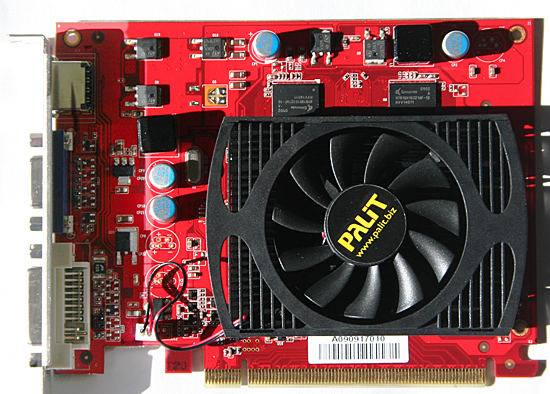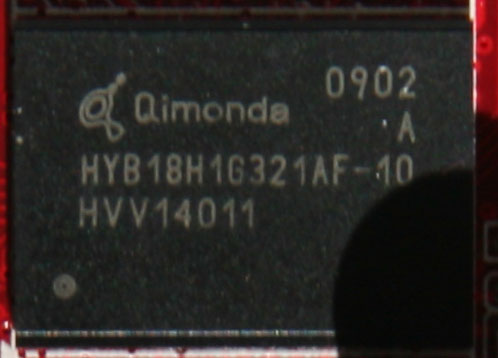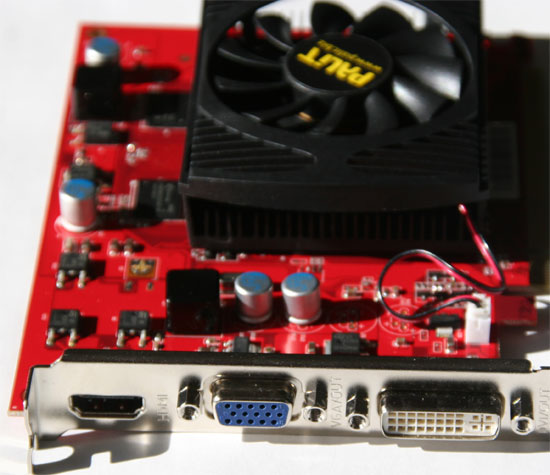NVIDIA’s GeForce GT 220: 40nm and DX10.1 for the Low-End
by Ryan Smith on October 12, 2009 6:00 AM EST- Posted in
- GPUs
Palit’s GT 220 Sonic Edition
As we mentioned in our introduction, for today’s launch we have a GT 220 graciously provided by Palit, in the form of their $79 GT 220 Sonic Edition. This card is ever so slightly factory overclocked, coming in at 650MHz for the core (a 4% overclock), a standard 1360MHz for the shaders, and 900MHz for its GDDR3 memory. As this is a GDDR3 card, it comes with 512MB of RAM.

As far as we know, this is as close to a reference cooler as you’re going to see for the GT 220, as we’ve seen this cooler on a couple other product brochures. It’s a rectangular single-slot height heatsink, with a fan mounted above it. This makes the entirety of the cooler wider than a single slot, and in practice this is a dual-slot card even if it’s not officially classified as such. The fan used is a simple two pin fan, so it blows at a fixed rate.

The 4 memory chips on this card are Qimonda HYB18H1G321AF-10. We haven’t been able to find the precise specs for that specific memory chip, but we believe it’s rated for 1000MHz, 100MHz over the operating speed of the card. We’re somewhat curious where Palit is getting these chips though, since Qimonda ceased production 6 months ago amidst bankruptcy. Apparently there’s a stockpile of these things somewhere.
Since it’s a low-power card, the overall design of the GT 220 Sonic Edition is rather simple compared to the complex beasts we see on the high-end. Nothing except the GT216 core itself is cooled, and we know that Palit is using solid OS-CON capacitors.

The port layout for this card is 1 HDMI port, 1 VGA port, and 1 DVI port, which appears to be the standard for the GT 220. With one of each port type, Palit’s GT220 Sonic Edition does not come with any port dongles. For that matter, the only other thing you’ll find in the box is a basic manual and driver CD (190.45).
| Form Factor | GT 220 Sonic 512MB | GT 220 1GB DDR3 | GT 220 1GB DDR2 | GT 220 512MB DDR2 |
| Stream Processors | 48 | 48 | 48 | 48 |
| Texture Address / Filtering | 16 / 16 | 16 / 16 | 16 / 16 | 16 / 16 |
| ROPs | 8 | 8 | 8 | 8 |
| Core Clock | 650MHz | 635MHz | 635MHz | 635MHz |
| Shader Clock | 1360MHz | 1360MHz | 1360MHz | 1360MHz |
| Memory Clock | 900MHz | 790MHz | 400MHz |
400MHz |
| Memory Bus Width | 128-bit | 128-bit | 128-bit | 128-bit |
| Frame Buffer | 512MB | 1GB | 1GB | 512MB |
| Transistor Count | 486M | 486M | 486M | 486M |
| Manufacturing Process | TSMC 40nm | TSMC 40nm | TSMC 40nm | TSMC 40nm |
| Price Point | $79 | ? | ? | ? |
Palit will be releasing three other GT 220 cards, in the other configurations that NVIDIA is allowing. These will be two DDR2-equiped cards with 512MB or 1GB of memory running at 400MHz, and a 1GB DDR3 card with its memory running at 790MHz. We don’t have these other cards on-hand, but based on the performance data supplied by Palit, the DDR3 card should be within 10% of the Sonic Edition, and the DDR2 card will be around 60% the speed.
Finally, Palit’s cards should be available from Newegg starting on Tuesday. Palit retreated from the North American market earlier this year to reorganize, so this marks the resumption of their North American retail sales.










80 Comments
View All Comments
Joe90 - Monday, October 12, 2009 - link
Last week I bought a Medion P6620 laptop. It's fitted with an Nvidia 220M graphics card with 512MB of GDDR3 ram. The blurb of the box said it was a DirectX 10.1 card. Have NV released any details about the laptop 220M as well as the desktop 220? All I could find out from Wikipedia & Notebookcheck.net was that the 220M was a 40 micron version of the 9600M GT but the Anandtech review suggests that things are more complicated than this.My only contribution to the debate is that I picked up this laptop for a paltry £399. Given that my machine has a T6500, 320GB HD, all I can think is that NV has be giving away the 220M to OEMs for pennies!
Finally, has anyone seen any signs of Windows 7 drivers for the 220M? I got a freebie upgrade but I'm a bit scared of using it just in case there were no drivers for a graphics card that NV don't recognise on their own website.
JarredWalton - Monday, October 12, 2009 - link
I'm assuming http://www.nvidia.com/object/notebook_winvista_win...">these won't work? I know they don't list 220M, but they're the latest official drivers from NVIDIA; otherwise you're stuck with whatever the notebook manufacturer has delivered. I'd guess NVIDIA will have updated mobile notebook reference drivers relatively soon, though, to coincide with the official Win7 launch.Joe90 - Tuesday, October 13, 2009 - link
Many thanks for the link. I think you're right. Although this NV driver page refers to the '200 series', it doesn't explicitly mention the 220M card. Until it does, I'll hang back from doing the Windows 7 upgrade.As it happens, I've only just made the leap from XP to Vista. Despite all the bad stuff I've read, Vista seems ok so I might just stick with it for a while. I'm finding I can play games ok with the Vista/220M combination. I'm currently playing FEAR 2 at 1366 x 768 with all the detail settings on maximum and the game plays fine. Given the low price of the laptop, I'm more than happy with the graphics performance.
JarredWalton - Tuesday, October 13, 2009 - link
I've never had a true hate for Vista, but there are areas I dislike (several clicks just to get to resolution adjustment, for example). Windows 7 is better in pretty much every way as far as I can tell, although it's not like Vista is horrible and Win7 is awesome. It's more like Vista reached a state of being "good enough" and 7 addresses a few remaining flaws.Now, if someone at MS would fix the glitch where my laptop power settings keep resetting.... (Every few tests, my battery saving options will reset to "default" and turn screen saver, system sleep, etc. on after I explicitly disabled it for testing. Annoying!)
plonk420 - Monday, October 12, 2009 - link
it's AMAZING for this gen's "lowest end" (at retail)... beats the pants off my 9400GT currently in my HTPC. probably even equals or betters my once only 2 generation old nearly high end HD3850.this is going in my HTPC in a heartbeat when it hits $30-35 (unless power consumption is stupid high, which i don't think it is. i THINK i read about this somewhere else, and someone was moaning about it using 4 watts more than some ATI part it was being compared to).
ltcommanderdata - Monday, October 12, 2009 - link
Given the more competitive desktop landscape, these new 40nm DX10.1 chips are not impressive at all. However, their mobile derivatives were announced months ago, and in the mobile space where mainstream GPUs seem to be made up of many, many combinations of nVidia's 32SP GPUs, a 40nm 48SP DX10.1 GPU would actually bring something to the table. It'd be great if we can get a review of a notebook with the GT 240M for instance.JarredWalton - Monday, October 12, 2009 - link
It looks like there are laptops with GT 240M starting at around $1100, and the jump from there to a 9800M card (96SPs, 256-bit RAM) is very small. Unless you can get GT 240M laptops for around $800, I don't see them being a big deal. Other factors could change my mind, though - battery life perhaps, or size/form factor considerations.apple3feet - Monday, October 12, 2009 - link
For some people, the most important detail of any new NVIDIA card is the CUDA Compute Capability. Will it run my scientific simulation code? Only if the CUDA Compute Capability is 1.3 - so that it supports double precision floating point arithmetic. Could we have just one line somewhere to tell us this vital info?jasperjones - Monday, October 12, 2009 - link
LOL,for dgemm (double-precision matrix multiplication) the GTX 285 is only about twice as fast as a Core i7 920 (using CUBLAS and Intel MKL, respectively).This suggests you shouldn't run your double precision code on a GT 220. Hell, even running CUDA code on your CPU using emulation might be faster than running on the GT 220..
apple3feet - Wednesday, October 14, 2009 - link
You're wrong. Given the right problem, tackled using the right algorithm, and well-written code, TESLAs can do 20x the throughput of a Nehalem - even in double precision.